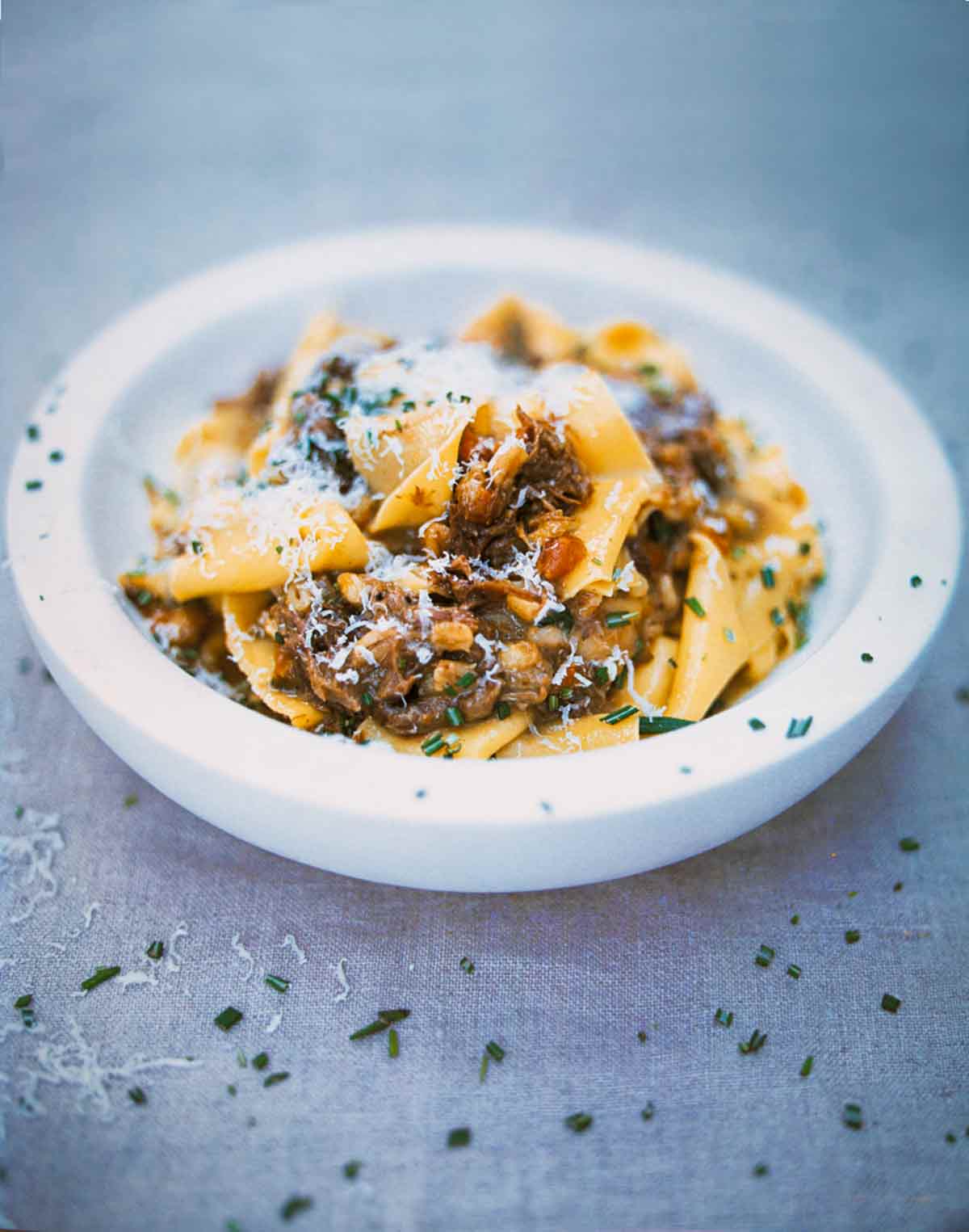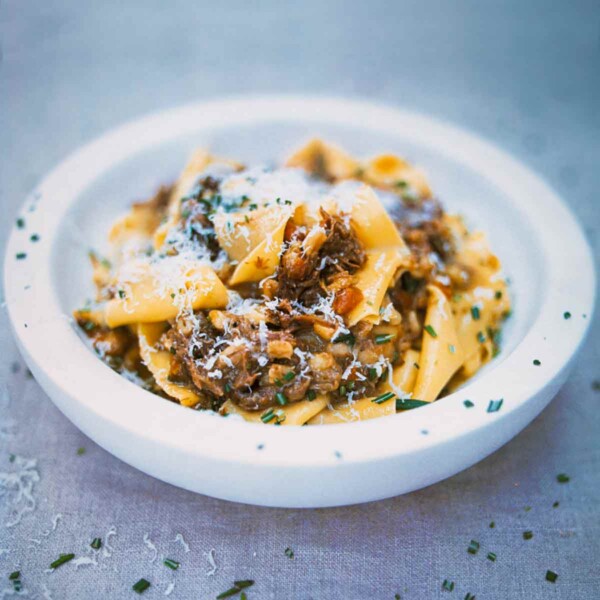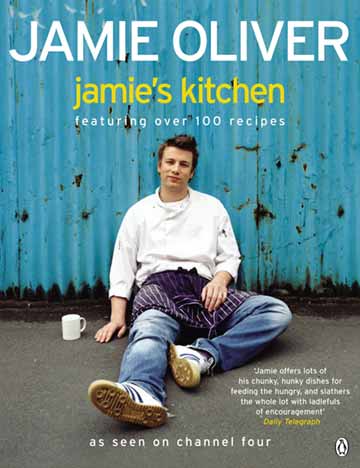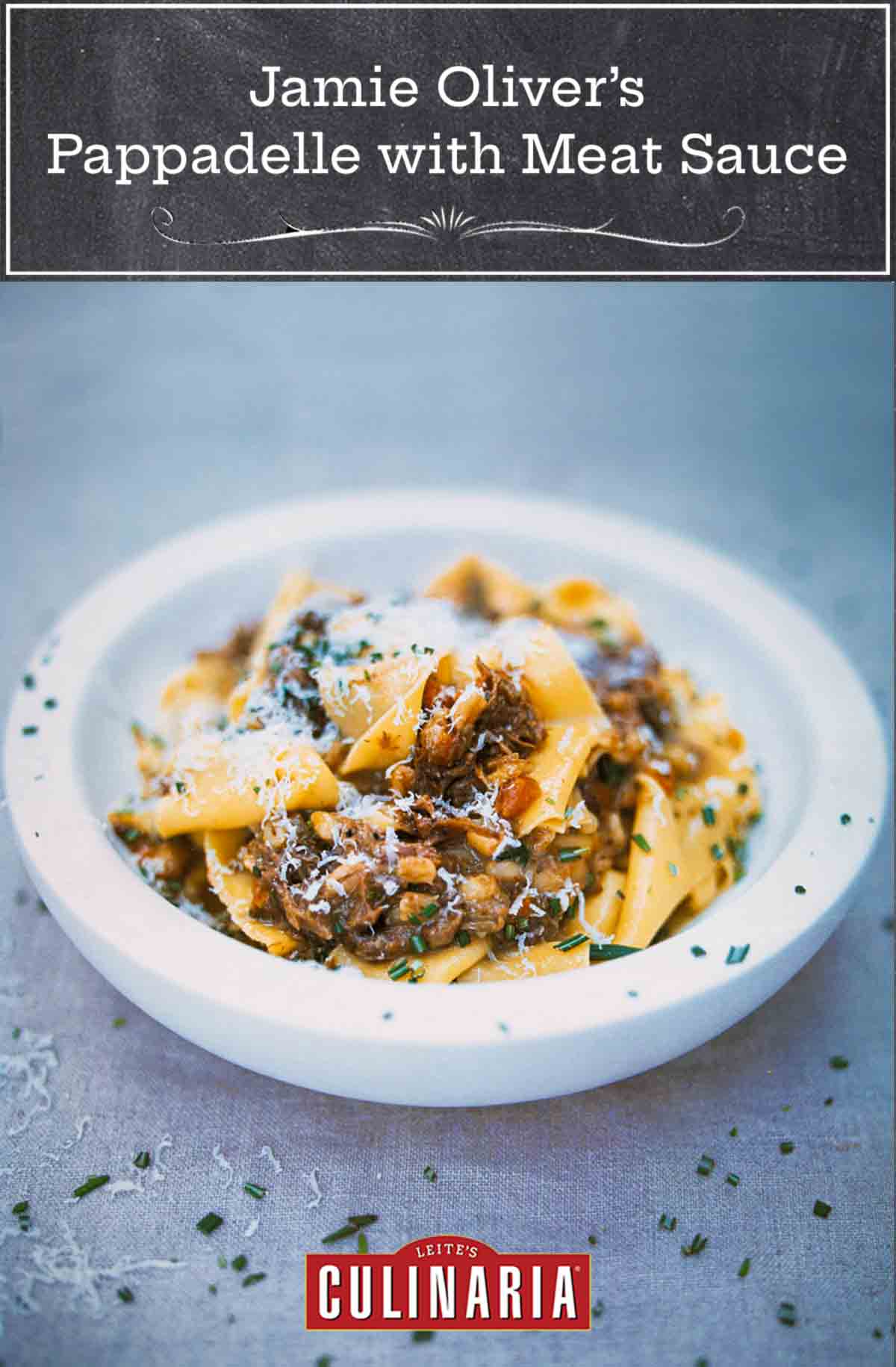
This pappardelle with beef ragu from food crusader and chef Jamie Oliver is, as the name implies, truly amazing. It’s essentially a braised meat sauce, although he notes that you could use venison or boar or squab or rabbit. Either way, it’s fabulously easy to make on the stovetop or in a slow cooker.
If you love the idea of saucy pappardelle, but don’t have 3 hours to spare, Jamie has a quick and easy sausage pappardelle that’s equally good.–David Leite
Pappardelle & Beef Ragu FAQs
Pappardelle are long, wide ribbons of pasta, customarily made with egg, originally from the Tuscany region of Italy. Its rough surface makes it ideal for hearty sauces typical of the region.
Its width varies between .75 to more than 1 inch. It’s the widest of all the long pasta shapes.
Beef ragu is just another name for beef sauce. It’s a hearty, seasoned sauce that customarily contains beef (ground), tomatoes, and finely diced onions, celery, and carrots called soffritto. Jamie Oliver’s beef ragu is made from meat that’s slowly braised so that it’s falling apart tender.
If you chose to pass on venison, boar, squab, and rabbit and prefer beef for Jamie Oliver’s beef ragu, the best thing to do is think cheap. Even the least expensive cut of beef, such as chuck or rump, will morph into something meltingly tender after a long, slow simmer in wine and aromatics, whether on the stovetop or in the slow cooker.

Jamie Oliver’s Pappardelle with Beef Ragu
Equipment
- Slow cooker (if following the slow cooker method)
Ingredients
- 1 1/2 pounds boneless beef chuck or rump, (or venison, boar, squab, or rabbit)
- Extra-virgin olive oil
- 1 handful each rosemary and thyme, stems discarded and leaves finely chopped
- 1 small red onion, peeled and finely chopped
- 4 garlic cloves, peeled and finely chopped
- 1 carrot, peeled and finely chopped
- 1 celery stick, finely chopped
- 2 wineglasses Chianti
- Two (14-ounce) cans plum tomatoes
- 2 tablespoons pearl barley
- Salt and freshly ground black pepper
- 14 ounces fresh or dried pappardelle
- 3 tablespoons unsalted butter, (if using venison, boar, squab, or rabbit use 5 tablespoons of butter)
- 2 handfuls grated Parmesan cheese, plus more for garnish
Instructions
- To make the pappardelle in your slow cooker, see the Slow Cooker Variation below. To make the pappardelle on your stovetop, season the meat with salt and pepper. (It can be cut into large 2-inch chunks if it's beef, venison, or wild boar; left whole if it's squab; or cut into 5 or 6 pieces if it's rabbit.)
- Place a Dutch oven over medium-high heat. Add a little olive oil and the meat, being careful not to crowd the pot, and cook until golden brown on all sides. It may be necessary to work in batches; if so, return all the meat to the pot after it's browned.
- Add your herbs, onions, garlic, carrot, and celery to the meat in the pot, reduce the heat, and continue to cook, stirring occasionally, until the vegetables have softened, about 5 minutes.
- Pour in the wine and simmer just until the liquid has almost completely cooked away but has left you with a fantastic color and fragrance. Add the plum tomatoes, the pearl barley, and just enough water to cover the meat by about 1/2 inch.
- Gently place the parchment circle directly on the surface of the liquid. Put a lid on the pot as well to retain as much moisture as possible while cooking.
- Reduce the heat to low and gentle simmer for 2 to 3 hours. The exact timing will depend on the tenderness and type of meat. You'll know that the meat is ready when you can literally tug on it with a fork and it easily pulls apart in strands.
- Season the beef ragu with salt and pepper to taste and let it cool slightly before removing the meat from the pan. Using 2 forks, pull apart all the chunks of meat, throwing away any gristle or bits of undissolved fat. Skim any fat from the surface of the braising liquid. Return the shredded meat to the pot and place over low heat.
- Bring a pot of heavily salted water to a boil and cook your pappardelle for 3 minutes if using fresh pasta or according to the package instructions if using dried. Once it's cooked, drain it in a colander, saving some of the cooking water.
- Remove the meat sauce from the heat and stir in the butter and Parmesan along with a little of the reserved pasta cooking water—this will make it juicy and shiny.
- Toss the beef ragu with your drained pasta and, if desired, serve sprinkled with a little finely chopped fresh rosemary and some more grated Parmesan. Serve immediately.
Notes
Jamie Oliver’s Pappardelle with Beef Ragu: Slow Cooker Variation
Toss everything in the slow cooker. No need to brown the meat or vegetables in a skillet first (although if you can spare the time to do so, you will be justly rewarded with a slightly more complex flavor). No need to add any water. And you may want to consider either swapping fresh herbs for dried or, if you prefer fresh, adding them only during the last hour or so of cooking. Cook on low for 8 or so hours, until the meat is fall-apart tender. If the beef ragu seems too liquidy, simply remove the meat, crank the slow cooker up to high, and simmer until the liquid is reduced to the desired consistency. Continue with step 7 in the instructions above. [Editor’s Note: Bear in mind, no two slow cookers are exactly alike, just as no two cooks are exactly alike. This slow-cooker approach worked really, really well for us, although if you have a different slow-cooker cooking technique you want to try by all means, do so. And, natch, we’d love if you’d share it with us in a comment below.]
Nutrition
Nutrition information is automatically calculated, so should only be used as an approximation.
Recipe Testers’ Reviews
Ah, Jamie Oliver recipes. Sometimes they’re more a list of suggestions than a strictly written recipe. This beautiful meat sauce is a classic example. The butcher is out of one cut of meat? That’s fine, just move on to the next. I used a rump roast because it looked much leaner than the chuck, and the flavor was still great. Don’t forget the final step of adding Parmesan and butter! Wow! That added so much flavor and texture. If—I mean when—I make this again, I may give it a little whirl with the immersion blender before returning the meat to the pot.
I love this Jamie Oliver’s recipe for pappardelle pasta! I can’t believe something that tastes so divine requires so little work. For the beef ragu, I used grass-fed beef roast and grass-fed beef stew meat already cut into chunks. I wouldn’t recommend using stew meat; the chunks were tender, but the meat remained as chunks even after cooking, whereas the roast practically fell apart. I browned the meat and veggies before throwing them into my slow cooker, and I didn’t add fresh herbs until the last hour of slow cooking. I used about a half bottle Chianti. This needed very little seasoning. I almost left out the butter, as it was delectable without it, but it was even more delicious with the butter. I cannot wait to make this again. It’s definitely a great dish to serve to company.
I made this pappardelle with beef sauce in the slow cooker, and it smelled amazing! It wasn’t as intensely flavored as I thought it would be, but it was really tasty nonetheless. I used half a bottle of Chianti and the full 28 ounces tomatoes, although I didn’t add any water.
I had to go out today, so I let it do its thing on low for 8 hours. The family really loved it. I think when I make this again—and I will make it again—I’ll try dried herbs instead of fresh, as I think the fresh may be too delicate for such a long cooking time, and I believe dried herbs will retain their flavor better. Or maybe I’ll add the fresh ones towards the end for a little more punch. I think this might be one of those recipes that’s better the next day, so I’ve packed some up for my lunch tomorrow.












I made Julia Child’s Boeuf a la Mode a couple of weeks ago from my original 1960s cookbook, which is pretty much the same. I don’t use the tomatoes, though — for some reason I don’t like the taste they impart. Must try it with a bit of barley, though I’ve always thought I didn’t like the gumminess of it.
(Nodding.) Jean, I tend to omit tomatoes, too, in braises even where they’re traditional. I think you’ll like the nutty heartiness that barley imparts to the dish. It could be my imagination, but when barley is cooked low and slow, I find the texture to be much more appealing than when it’s cooked hard and fast as in a quick boil. Perhaps you’ll feel the same…
Delicious recipie. I used rolled brisket of beef as this is one of the best cuts for pulled beef style recipes and is good for very slow cooking I’m also going to try it with beef short ribs as I think cooking this with beef on the bone would add extra flavour. I will remove the beef from the bones before putting back in the sauce.
I cooked mine in the fan oven for 5 hours at 140 degrees centigrade and when the beef was ready I took it out and reduced the sauce until it was the consistency I wanted before putting the beef back in.
Lovely, Anna. Thank so much for taking the time to share your technique and tricks. I now have beef short ribs on the mind and shall have to do something with them this weekend…probably this very recipe.
I was given Jamie’s book above as a present, and I keep coming back and back to this recipe. I use the slow cooker version. Sometimes I add a little extra barley and leave out the pasta, then turn it into bowl food.
Sounds fantastic, Annette. Many thanks for sharing your trick, I know it’ll come in handy for us as well as others.